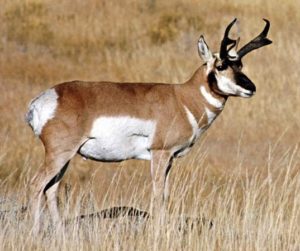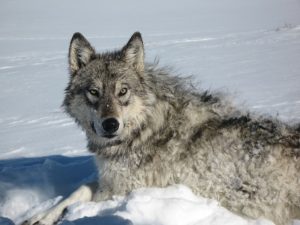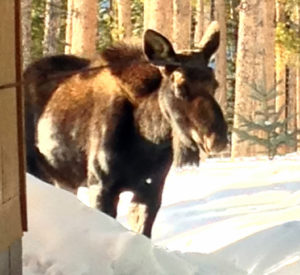
I had an idea for an article, but truthfully, I half-assumed there wouldn’t be enough interesting things to write about. I mean, it’s a little deer. Big deal. I may never have been so wrong. These creatures showed up in my consciousness when we were passing the biggest hill of the unfinished golf course, just beyond the I-40 and I-34 intersection toward Grand Lake. There had to be fifty antelope catching some rays. Did you catch my error? I’ve been calling these animals antelope since I moved to Colorado. But antelope live in Africa; pronghorns live in North America. If you’ve made the same mistake, you’re not alone. Even the RMNP calls them “pronghorn antelope,” but since there’s only been one confirmed sighting in the Park—ever—we can give them a break.
African antelope resemble deer, although they’re in the bovine family, whereas pronghorns are seriously unique. To start, their DNA more closely matches a giraffe than any other animal, even though they didn’t migrate from Africa eons ago. Experts believe pronghorns are the only large mammal alive today that originated in North America, and then these homebodies stayed here for another nineteen million years. They’re also the sole living species of Antilocapridae. Today, they live mainly in the U.S.’s Great Plains, with the largest number in Wyoming.
Depending on whether you more value sprinters or long-distance runners, they are debatably the fastest land animal on earth, clocking in at sixty mph. A cheetah is as fast, but they can only maintain that speed for short bursts, whereas a pronghorn can Forest Gump it for miles. “Wild Earth” contributor Tom Butler calls them a true ecological anachronism because they have no predator alive today that can match their speed (except for good ol’ boys in a pickup truck).
Even the growth on their noggin is a head-scratcher. It’s officially classified as a horn, although it’s forked, but the outer sheath is shed each year, which is more like an antler. The tips of their horn/antler curl backwards and its surface’s texture resembles glued-down, thick, black hair. Unlike most animals, the females also have little horns. At the front of their headgear is a small notch, or prong, that points forward. Hence their name.
Their communication style is also different. If they sense danger, they release a musky scent and raise the white hair on their rump, like my dog when she senses a fox. Pronghorns have exceptional eyesight and can notice movement from three miles away. But when that amazing trait is coupled with their extreme curiosity, it can get them in trouble big time. A sure way to bait them, for either photography or hunting, is to tie a brightly colored scarf to something above the grasses. They will compliantly come over to check out what it is.
Final cool pronghorn fact: they don’t need to drink! If water is unavailable, they are able to extract enough from the plants they consume. I now lower my head in shame for ever thinking these literally one-of-a-kind creatures are merely ordinary.
This article orginally appeared in The Boardwalk newspaper, Grand Lake, Colorado.

